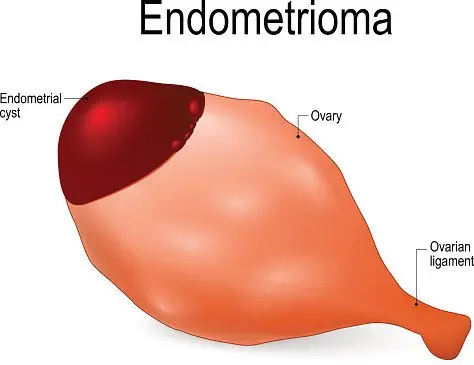What is Endometriosis?

Endometrial tissue lines the inside of the uterus. In endometriosis, the same type of tissue also grows in places outside of the uterus.
Implants or patches of endometriosis may develop in the:
- Ovaries
- Outside surface of the uterus
- Pelvis and lower abdomen
- Fallopian tubes
- Spaces between the bladder, uterus and rectum
- Wall of the rectum, bladder, intestines or appendix (less commonly)
- Lung, arm, thigh and skin. (This is rare.)
Misplaced endometrial tissue behaves like endometrial tissue in the uterus. It responds to the monthly rise and fall of female hormones. At the time of menstruation, endometrial tissue outside the uterus also can ooze blood, and cause pelvic or abdominal pain.
If the misplaced endometrial tissue enlarges to cover or grow into the ovaries, or if it blocks the fallopian tubes, it can it can interfere with a woman's fertility by blocking the passage of an egg from the ovaries into the uterus.
Endometrial tissue on the ovaries may form into large fluid-filled cysts. These are called endometriomas.
|
|
A woman may have an increased risk of endometriosis if:
- She has a heavy menstrual flow.
- She has a short menstrual cycle (27 days or less).
- She has a close female relative with endometriosis.
A woman's risk may be lower than average if:
- She has had multiple pregnancies.
- She has breast fed for longer periods of time.
- Her diet is rich in omega-3 fatty acids.
Symptoms
Many women with endometriosis do not have any symptoms from it. Those who have symptoms may experience:
- Severe discomfort, usually with heavy flow, during menstrual periods
- Pain in the pelvis or abdomen, usually just before or during menstruation, but sometimes throughout the month
- Backache
- Pain during or immediately after sexual intercourse
- Vaginal spotting before menstruation begins
- Bowel symptoms, such as:
- Painful bowel movements
- Diarrhea
- Constipation
- Rarely, blood in the stool
- Painful urination, or, rarely, blood in the urine
- Infertility or repeated miscarriages
Diagnosis
The doctor will review:
- Your symptoms
- Your medical and gynecological history
- Family history of endometriosis
This will be followed by a physical exam and a pelvic exam.
During the pelvic exam, your doctor may be able to feel the following signs of endometriosis.
- Endometrial tissue embedded in the ligaments of your pelvis
- Displaced pelvic organs
- How freely your pelvic organs may be moved
- An ovarian endometrioma—a deposit of endometrial tissue on your ovaries
To confirm the diagnosis, your doctor may need to do pelvic laparoscopic surgery. In this surgery, doctors operate through two or three tiny incisions. The surgery can identify endometrial tissue inside your pelvis or abdomen. Abnormal tissue may be removed for biopsy during the surgery.
Expected Duration
Without treatment, endometriosis is a long-term problem. It usually lasts until menopause. After menopause, areas of misplaced endometrial tissue tend to become smaller, and are less likely to cause symptoms. That is particularly true if your symptoms have come only during menstrual periods.
Prevention
There is no way to prevent endometriosis.
The condition may temporarily stop progressing if you:
- Use oral contraceptives
- Become pregnant
Treatment
Several treatment options are available.
Pain management
For mild pelvic or abdominal pain, you may try a nonprescription pain medication. Examples include ibuprofen (Advil, Motrin) or naproxen (Aleve). If this doesn't help, your doctor may suggest a prescription-strength nonsteroidal pain reliever.
Stronger medications that contain a mild narcotic are available. But narcotics pose a risk of drug dependence and addiction. They are prescribed only when other pain medications fail or can't be used because of side effects or allergic reactions.
Treatments that control hormone levels
Some treatments relieve pain by controlling levels of female hormones, particularly if your symptoms occur mainly or only during menstrual periods. These include:
- Oral contraceptives
- Progestins
- Progesterone antagonists
- Danazol (Danocrine)
- Gonadotropin-releasing hormone (GnRH) agonists. GnRH agonists temporarily, but dramatically, decrease levels of female hormones. Since these hormones encourage the inflammation within patches of endometriosis that cause the symptoms of the disease, decreasing the levels of these hormones often improves the symptoms.
- Elagolix (ORILISSA). Elagolix is gonadotropin-releasing hormone (GnRH) antagonist approved for the treatment of moderate to severe pain from endometriosis. It is contraindicated in women with osteoporosis or severe liver disease. Long term use may be associated with bone loss.
- Aromatase inhibitors—drugs used to treat breast cancer that seem to decrease the amount of estrogen in patches of endometriosis (although they are not yet officially approved for such use). The two most commonly used aromatase inhibitors are anastrozole and letrozole.
Conservative surgical treatments
During laparoscopy, your doctor will destroy small areas of extra endometrial tissue that are implanted outside the uterus. He may burn them away or use a laser to vaporize them. Your doctor also may trim away tissue that is displacing your pelvic organs. These procedures often can be done during a diagnostic laparoscopy session.
|
|
For more extensive endometriosis, you may need traditional abdominal surgery. This is done through a larger incision. The larger incision provides more room to reach and treat all areas of endometriosis inside your pelvis and abdomen.
Hysterectomy
The doctor may treat endometriosis by removing the uterus, ovaries and fallopian tubes. Hysterectomy is a last resort when other measures have failed. It is only performed in women with severe disabling pain who no longer want to become pregnant.
The treatment option that is best for you depends on several factors. These include the severity of your symptoms and your plans for pregnancy.
Treatment options
The following list of medications are in some way related to or used in the treatment of this condition.
- norethindrone
- Orilissa
- Lupron Depot
- Zoladex
- Provera
View more treatment options
When To Call A Professional
Call your doctor or gynecologist if you experience:
- Unusual and severe pain just before or during your menstrual period
- Pelvic or abdominal pain
- Abnormally heavy menstrual periods
- Vaginal spotting
- Any other symptom of endometriosis
Also contact your doctor if you have been unable to conceive a child after one year of unprotected intercourse.
Prognosis
The outlook is good, especially when endometriosis is diagnosed and treated early. Medical and surgical treatments can relieve the pain of endometriosis in most women.
Even without treatment, the majority of women with mild endometriosis eventually can become pregnant. Many women who have laparoscopic surgery to improve their fertility become pregnant.
Symptoms of endometriosis go away after menopause, as long as estrogen treatment is not used.
Additional Info
National Institute of Child Health & Human Development
http://www.nichd.nih.gov/
Endometriosis Association
http://www.endometriosisassn.org/






